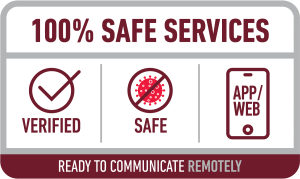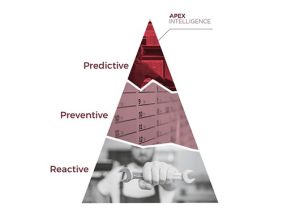How to maintain buildings during COVID-19?
How to maintain buildings during COVID-19?
The surprise wave of COVID-19 this year has become a major challenge for almost the entire business sector. The inconvenience caused by the pandemic not only demonstrated the resilience of businesses, but also the ability to respond to the situation in a flash, flexibly adapting to the crisis caused by the virus. It has become clear that in some industries, the traditional business model is not prepared for such challenges, and provision of physical services to customers is either insecure or impossible at all. Building managers have to choose between saving energy resources and more intensive ventilation and virus prevention. As with everything these days, you need to respond quickly and professionally. So how do you maintain buildings in these extraordinary circumstances?
Is disinfection important?
The recommendations of the Lithuanian Ministry of Health, which are based on the latest guidelines of international organizations, advise to clean all premises / surfaces as often as possible during a pandemic in order to stop the spread of COVID-19 virus as effectively as possible. Both daily indoor hygiene with preventive disinfection and disinfection after the detection of COVID-19 are necessary measures to reduce the risk of COVID-19 infection and to eliminate it completely.
Success stories and good practices - digitization of buildings
Buildings without remote control are indeed facing challenges. Even those with BMS systems often become inaccessible. In principle, we successfully manage those buildings that are digitized and connected to the APEX Intelligence remote control center. This is a new model of building maintenance, which makes building maintenance significantly more efficient, requires less inefficient actions, ensures continuous maintenance of systems, reduces the risk of equipment downtime, increases work efficiency and saves energy costs. Building systems are constantly monitored remotely, data flows are analyzed, and thanks to appropriate algorithms, the system automatically informs about equipment failures and anticipates possible failures and losses. With enough data, we can immediately form the best solution / control algorithm. For example, when the humidity and temperature outside changes, we can react quickly and change the parameters. Thus, we can maintain a balance between health, because we work remotely and finance energy costs.
"eCSE" is a tool for your phone
We are responsible for the maintenance of your property, therefore we would like to emphasize once again that we are able to organize the management of buildings without direct physical contact at the client's site. Use "eCSE", a self-service platform and mobile application for all users of the facility, for convenient and secure communication. Many of our customers are already convinced that this tool can solve problems faster, more conveniently and, most importantly, more safely, as physical contact is eliminated.
Other relevant tips
• If the flow of people in the building decreases, it is necessary to review the heating, ventilation and air conditioning parameters to meet the needs of employment or operation. Unnecessary costs would be avoided. Keep in mind the risk of quick temperature decreases. Also pay attention to supporting systems, the operation of circulating pumps.
• Secure the power supply.
• Even if buildings are not occupied, insufficient temperature and humidity control can cause mold to grow.
• Keep the temperature of the building between 13 and 27 degrees and the humidity (in case of a virus) between 50 and 65%. However, do not exceed the dew point values.
• Carry out preventive maintenance (heating, ventilation and air conditioning, power supply, lighting) until the buildings are occupied.
• Perform a preventive inspection of emergency power supply systems for use if necessary.
Contact us if you have any questions or would like to consult.
Are your buildings ready for the heating season?
As the heating season approaches and in order to avoid problems, it is necessary to properly prepare the heating systems of buildings.
Key steps to take:
• Clean or inspect the chimney (if any).
• Prepare the heating appliance for the season, clean and adjust it.
• If the heating system has intermediate heat exchangers - they must be cleaned for hot water preparation and heating, otherwise the efficiency of the heating system will decrease. This can cause problems such as not having enough heating on a very cold day.
• Check the operation of all circulation pumps.
• Clean the heating system dirt collectors.
• Top up the heating system to operating pressure.
• Bleed air from the heating system.
• Check the expansion vessel.
• Check the operation of all automatic actuators / valves.
• Check the operation of all temperature sensors.
• Check protection systems against water pressure increase; from an increase in temperature (if any).
• Check the shut-off valves, as they must be leak-proof in an emergency.
• Repair (if damaged) the insulation of the heating pipes to prevent heat loss.
• Check the thermostatic valves of all heating appliances (they are usually mounted on radiators).
• Check the operation of the controls in the room (sometimes they work with batteries, check for discharge).
It is recommended to periodically inventory the heating system of the building, checking whether the heating devices and stand balancing devices correspond to the design project. The inspection may be carried out by the building manager or the building heating and hot water system supervisor.
As the heating season accelerates, temperature fluctuations usually cause significant heat loss during the day / night, even with automated microclimate control. Buildings are overheated and thus heating costs increase. Due to this unstable heat demand, it is necessary to additionally control the buildings and change the settings of the equipment, depending on the outdoor weather conditions. This optimizes the cost of heating buildings.
Our customers can await the heating season calmly, because in the facilities where we maintain the heating system (s), we perform the planned work preventively. We understand that consistently preparing for the heating season increases the efficiency of heating, the service life of the heating system is increased, and more energy is absorbed. Conversely, without periodic maintenance of equipment, there is an increased risk of freezing the building, spilling water in the premises, or damaging the equipment. Therefore, it is very important to prepare the buildings responsibly and in time for the heating season.
New agreement with SEB bank
At the beginning of the autumn, new important customer joined a base of the long-term customers of “City Service Engineering”. This demonstrates yet again the importance of continuous improvement. From now on we will maintain the customer service divisions and administrative premises of SEB bank throughout Lithuania. We have 27 objects in our account! We will also provide services of dealing with emergency situations.
“The customer choice, without doubt, was determined by our professionalism and excellence in the Energy sector. We earned customer confidence with our experience and implemented projects, and it evolved into a cooperation. We believe that together with SEB bank we will manage to deliver excellent results”, - says Šarūnas Šetikas, the Head of Sales Team at CSE.
How do we organise work during the COVID-19 pandemic?
There are some services related to commercial building maintenance, such as work of emergency service, that cannot be provided remotely. The Company continues organising activities of the emergency service and of the specialists performing various repair works in such a way that allows as little contact with customers as possible. The specialists are supplied with all necessary safeguards, and therefore they go to objects in full preparedness and abiding to preventive measures.


Placing a respirator on the face
• Before placing a respirator on the face, be sure to disinfect your hands.
• Before taking off a respirator, be sure to disinfect your hands, also wipe the inside and outside of the respirator with a disinfectant wipe or disposable handkerchief dampened with disinfectant. After cleaning, place the respirator in a bag.
Hand disinfection (these rules also apply when the worker is wearing gloves)
• Before placing a respirator on the face, hands need to be disinfected and gloves to be put on. Following these steps, the respirator can be placed on the face.
• When taking off a respirator, hands need to be disinfected, the respirator and gloves taken off, and then hands need to be disinfected once again.
How to disinfect hands?

New agreement with SBA Technology and Innovation Park
We are proud being able to offer our customers smart building maintenance solutions – through the use of building management system (PMS) which makes it possible to remotely control engineering systems in a convenient way and to optimize energy consumption of the building
“We are very happy with this new customer that is the leader in its business sectors and continuously introduces the latest technologies not only in production processes but also in building stock management processes. It is a welcome fact that the customer approach to building stock management coincides with our experience and digital tools, using which we can provide quality services”, - says Ignas Urbonas, Head for Western and Central Lithuania Regions at City Service Engineering. Let‘s go forward and never stop!

Ready for the second Covid wave!
Dear customer,
The surprise wave of COVID-19 this year has become a major challenge for almost the entire business sector. The inconvenience caused by the pandemic not only demonstrated the resilience of businesses, but also the ability to respond to the situation in a flash, flexibly adapting to the crisis caused by the virus. It has become clear that in some industries, the traditional business model is not prepared for such challenges, and provision of physical services to customers is either insecure or impossible at all.
Even before COVID-19, "City Service Engineering" developed and implemented digitized systems that allow to provide the highest quality maintenance services all of its customers while minimizing physical contact. We have long believed that this is the future of sustainable business, although the pandemic has shown that that future has turned into the present very rapidly. We are pleased to be the first on the market to be able to handle many building maintenances issues safely and sustainably in a remote way. Today we can firmly guarantee that we are 100% ready for that.
For more than 20 years, "City Service Engineering" has always strived to be one step ahead in the building maintenance market. We have no doubt that only with the solutions, innovations created and implemented by us and our ability to quickly react to changes have we earned the trust of our customers. Every year, we sign over 100 building management contracts with both large and smaller companies. Today we provide services to more than 9000 clients throughout Lithuania.
We are responsible for the maintenance of your property; therefore, we would like to emphasize once again that we are able to carry out the organization of building management without direct physical contact at the customer's site. For convenient and secure communication, we have created a new generation communication tool named "eCSE" - a self-service platform and mobile application for all users of the object. Many of our customers are already convinced that with this tool it is possible to solve problems faster, more conveniently and, most importantly, more safely, as physical contact is eliminated.
We have been providing services to you for some time in accordance with the new business logic. If we used to work according to the "Customer-Employee" principle, then from now on we provide services in a different way - as in "Customer-Perfectly functioning system". As a result, the speed of the service changes, as the system allows to significantly speed up the resolution of customer problems. In other words, all requests are currently visible in the system, so they are processed much faster, and the customer is given real-time feedback when the status is changed.
We use digital products, and this ensures the provision of fast and high-quality services to you. In addition, thanks to digital technology, we can use the most suitable external partners and all this so that the assets you manage are only our concern.
We recently introduced another innovation - "Apex Intelligence". This is a new model of building maintenance, which makes building maintenance significantly more efficient, requires less inefficient actions, ensures continuous maintenance of systems, reduces the risk of equipment downtime, increases work efficiency, and saves energy costs. Building systems are constantly monitored remotely, data flows are analyzed, and thanks to appropriate algorithms, the system automatically informs about equipment failures and anticipates possible failures and losses.
We strive to provide services perfectly, but sometimes we also make mistakes, but we are never afraid to acknowledge this and take responsibility. Despite the occasional problems, almost 350 "City Service Engineering" employees constantly take care of the smooth management of your building every day.

The dilemma: whether or not is it possible to reduce both costs and risks?
The dilemma: whether or not is it possible to reduce both costs and risks? What the world will choose in 2020-2026?
Wrong system maintenance strategy may in principle determine overall productivity of the organization. No matter whether it is a manufacturing company, a real estate developer or a shopping centre. Everyone has the same dilemma to solve: how to maintain a balance between costs/expenses that are allocated to system maintenance and risk of failure, production downtime, inappropriate comfort, complaints or waste of energy resources. All this can be called the impact of system/building maintenance service. Maintenance service itself determines up to 30% of the overall productivity of the building or maintenance process.
New cost-reducing maintenance model
Maintenance and service models
The market for the predictive maintenance model is expanding globally at an annual rate of 25.2% from USD 4 billion in 2020 to a projected USD 12.3 billion in 2025. Such expansion is not accidental. Based on the global practice, the predictive maintenance model is up to 30% more efficient compared to other two system/building maintenance models - reactive and preventive. Let us examine the use, benefits and advantages of these 3 models.

III. Model – Predictive
Analytical data processing. Insights that can help predict equipment failures and verify service actions.
II. Model – Preventive
Scheduled performance of service works. Management/monitoring of engineering systems and data collection.
I. Model – Reactive
Accidents and repairs. Emergency response.
APEX Intelligence – APEX Intelligence - purposeful data traffic collection, analysis and management.
The use of equipment until the failure thereof is described as a reactive maintenance model. It is used for certain systems/equipment, the failure of which cannot lead to significant losses. For example, it is obvious that failure of one luminaire does not pose significant risks or potential loss. Usually, no special checks or inspections are required for luminaire to operate. In such cases, a reactive maintenance model is used.
However, there are systems whose malfunctioning may lead to significant losses or risks. For example, the operation of a fire alarm requires periodic inspections and tests. The scheduled preventive checks-inspections of systems are used for that purpose. The same is true for the lighting system. Imagine that if a lighting control time relay, which is responsible for switching off the light during non-working hours, does not work, failure of this system can already lead to up to 10% higher electricity consumption. Consequently, scheduled inspections for a part of this system may reduce waste of energy resources.
Up to 8 different systems or hundreds of different devices may simultaneously operate in the building. Therefore, an appropriate maintenance model needs to be adapted for each system not only for us to be able to ensure the requirements of Lithuanian legislation but also that we could make good use of the productivity of building systems by eliminating risks or losses of energy consumption. For example, heating, ventilation and air conditioning (HVAC) systems in the building account of up to 40% of energy costs. In addition, the operation of these systems ensures by 100% the comfort of people who are present in the building. Nevertheless, the reactive maintenance model or insufficient periodicity of scheduled inspections is incorrectly applied to the maintenance of these systems.
Naturally, an inspection of the HVAC system 365 times a year, when calculating wages, would cost a lot. Therefore, despite the importance of the proper system operation, the number of periodic inspections is reduced. Verification of the operation of these systems using digitization technologies is the only effective way to maintain a balance between the costs of maintenance and the impact of the service provided - comfort and optimal energy costs.
So, application of digitization for equipment maintenance is the essence of predictive maintenance which reduces the cost of maintenance itself and ensures efficient 24/7 operation of equipment.
What is the situation in Lithuania?
In Lithuania, up to 90% of organizations use reactive and preventive maintenance models in formulating a system maintenance strategy. Efforts are made to balance between minimum costs and requirements defined in the state acts. Lithuania, however, still lags behind the practice of other countries, where the third maintenance model - the model of predictive maintenance, that was mentioned above, is becoming particularly popular.
Sometimes we do not realize that the predictive maintenance model can already be used today in the majority of buildings without significant investment. Investment in building automation has been growing in the past 10 years. Therefore, the data collected about buildings can be easily used for more efficient system maintenance.
“APEX Intelligence”, an independent data analytics centre founded by “City Service Engineering”, ensures efficient collection and use of building data and the predictive performance of maintenance.
The professionals of "City Service Engineering“ can perform system digitization analysis in your building and provide suggestions on how to optimize building maintenance.







